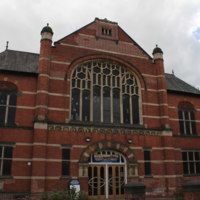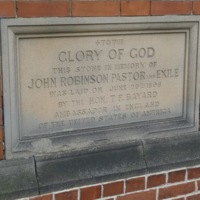Description
Interest in the Pilgrim Fathers was growing among Congregationalists on both sides of the Atlantic in the late 19th century. In 1891, the first International Congregational Council was held in London - an opportunity for Americans to tour the Pilgrim sites of the Old World. As part of the same European trip, the National Council of the Congregational Churches of the USA unveiled a tablet to the memory of John Robinson in Leiden, where the East Midlands-born Separatist leader had ministered to the exiled Pilgrims before their move to the New World in 1620. Delegates from the USA, Britain and the Netherlands came together for the unveiling at the Pieterskerk, celebrating his life and connection to the USA – despite the fact he himself had never left Europe.
Back in the small Lincolnshire town of Gainsborough, Rev. H.S. Griffiths had just become the pastor of the Congregational church, cooped up in a small and inconvenient chapel in a backstreet. Seeing growing local demand, he made it a priority to erect a new place of worship. Tapping into the American enthusiasm for commemorating Robinson was one way to gain funding. Gainsborough, after all, was an important historical site of nonconformity. John Smyth, who became one of the leaders of the Separatist movement in the north of England, had secretly preached in Gainsborough. While doing so he had met with John Robinson, who went on to lead the congregation at Scrooby. Claims that Robinson had also been born in Gainsborough were less verifiable – and indeed later disproved – but good grist for the mill in the meantime.
Griffiths began corresponding with Dr Rev C.R. Palmer of Bridgeport, Connecticut, an important figure in the erecting of the Leiden memorial, looking to find American support for the endeavour. A money-raising campaign also began in earnest back home. Special services, fetes and bazaars were held throughout the 1890s to raise the cash (at that time, estimated at £5,000). Funds also came from local subscriptions, the Congregational Union via London, and a large amount from the USA too (helped by Alexander Mackenall, one of the Union’s most effective fundraisers). By 1896, enough funds had been found to begin the building process. On a July afternoon, a great day of parades, speeches and ceremonies marked the occasion.
American Congregationalists – with lineal descendants of Robinson, William Brewster and William Bradford – had already planned an excursion to Britain, and thus came in a large party. In the previous days they had been touring Cambridge, Boston and Lincoln, and had spent the morning looking at other Pilgrim Father places in the region (Scrooby, Bawtry and Austerfield). Welcoming them to Gainsborough, the chairman of the Urban District Council gave a civic luncheon in the Old Hall, where the health of the Queen and the American President were toasted and the memory of the Pilgrims lauded. According to the Chair of the Council, Gainsborough was ‘a very ancient town’ where ‘John Robinson and many of the Pilgrim Fathers started on their journey to the West’. He was, he said, ‘quite aware of the great importance, both to the United States and to Great Britain, of a thoroughly friendly feeling’.
T.F. Bayard, the first United States Ambassador to the United Kingdom and special guest for the day, was also well aware of the Anglo-American relationship. For him, the Memorial Church was a good opportunity to use the Mayflower – a growing symbol of the common heritage of Britain and the USA – as a tool of public diplomacy. In the 1890s, the two countries were beginning to grow closer but there were still moments of tension (like the dispute between British Guiana and the American supported Venezuela in 1895). Bayard ‘hoped that the time would never come’ when ‘toasts’ to the USA ‘were not drunk with the good feeling that at present existed.’
After being presented with a silver and ebony trowel (complete with a Mayflower emblem), the Ambassador laid the ceremonial foundation stone – engraved ‘In memory of John Robinson, pastor and exile’. Representatives from Congregationalist communities from all parts of the country had made the journey to witness the event. Bayard addressed the gathered crowd, and said it was ‘clear’ that ‘the departure from England of John Robinson and his followers was a great step in the march of Christian civilisation. It contained the seed of Christian liberty, freedom of inquiry, and to man’s conscience.’
In June 1897, though not yet fully completed, the church was finally opened. Designed by R.C. and E. Sutton of Nottingham, it was big enough to accommodate 600 persons. As the Lincolnshire Echo put it, the ‘whole interior’ was ‘splendidly arranged’, but ‘ornamentation’ was ‘almost wholly absent’ and ‘the exterior… also very plain’ – respecting the simplicity of Congregationalist beliefs. The end cost was £7,200 – and, at that point, £3,000 was still needed. Money raising continued until, in mid-1902, the Rev George R.W. Scott brought over a final £1,000 from the American Council of the Congregationalists to clear the debt. Services and commemorations again took place, and a bronze tablet – complete with an engraving of the Mayflower – was unveiled in the church to celebrate the successful co-operation of English and American Congregationalists.
Source
For the full story, see Erik Goldstein, 'Building the Anglo-American Relationship – The John Robinson Memorial Church, Gainsborough, Lincolnshire', Congregational History, 9:2 (2019), 67-80.
Other sources:
See the many articles in the local press, particularly:
‘Pilgrims at Gainsborough’, Sheffield Daily Telegraph (29th June 1896), 6.
‘The Pilgrim Fathers’, Lincolnshire Echo (10th June 1897), 2



